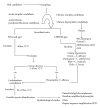Isolation and identification of Candida from the oral cavity
- PMID: 22111010
- PMCID: PMC3205665
- DOI: 10.5402/2011/487921
Isolation and identification of Candida from the oral cavity
Abstract
Various techniques are available for the isolation of Candida within the oral cavity. Such methods play an important role in the diagnosis and management of oral candidosis. The growing importance of Candida is in part related to the emergence of HIV infection and the more widespread use of immunosuppressive chemotherapy. Along with the Candida albicans there has been a greater recognition of the importance of the nonalbicans Candida species in oral candidosis. Identification of infecting strains of Candida is important because isolates of Candida species differ widely, both in their ability to cause infection and also in their susceptibility to antifungal agents. Thus this review provides an overview of the reliable methods of candidal isolation and identification of isolates from the oral cavity.
Figures
References
-
- Zunt SL. Oral candidiasis: diagnosis and treartment. The Journal of Practical Hygiene. 2000;9:31–36.
-
- Soysa NS, Samaranayake LP, Ellepola ANB. Antimicrobials as a contributory factor in oral candidosis—a brief overview. Oral Diseases. 2008;14(2):138–143. - PubMed
-
- Scully C, Ei-Kabir M, Samaranayake LP. Candida and oral candidosis: a review. Critical Reviews in Oral Biology and Medicine. 1994;5(2):125–157. - PubMed
-
- Epstein JB, Komiyama K, Duncan D. Oral topical steroids and secondary oral candidiasis. Journal of Oral Medicine. 1986;41(4):223–227. - PubMed
-
- Pomerantz S, Sarosi GA. Fungal diseases in AIDS. Current Opinion in Infectious Diseases. 1992;5(2):226–230.
LinkOut - more resources
Full Text Sources


